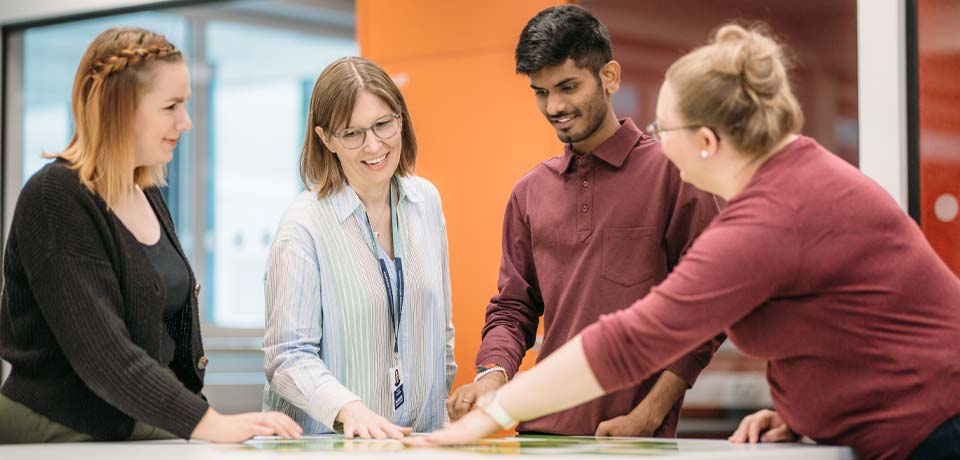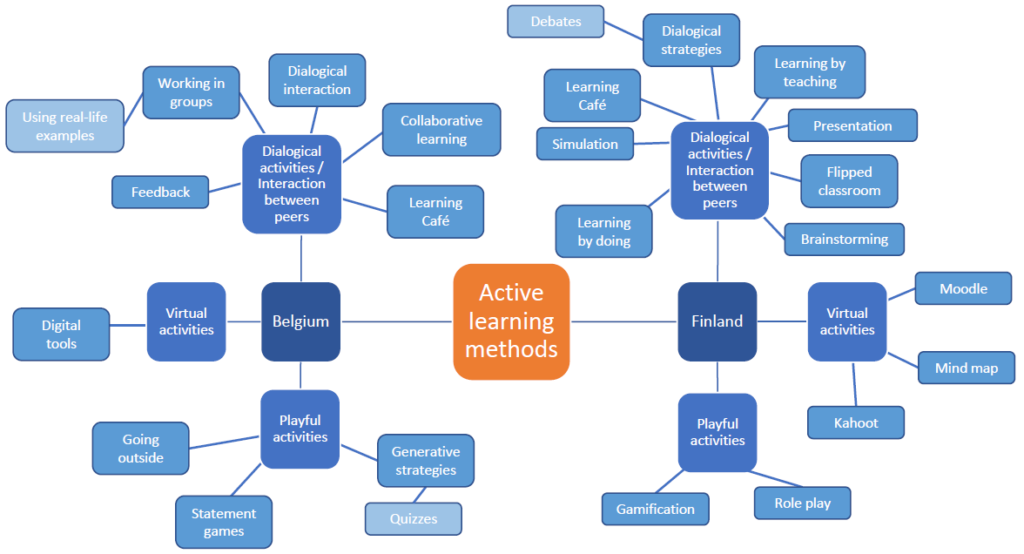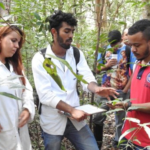
Evelyn Ansah Karkkulainen, Líbia Barbosa & Jukka Niinimäki
The framework for learning patterns, known as the Student Approaches, to Learn (SAL) tradition, was developed in the late 1970s and early 1980s by academics from Australia, Sweden, and the UK. Cognitive techniques are primarily used to conceive and motivate students (Pask, 1988; Schmeck, R. R., 1988). The students are mainly conceptualized and inspired by cognitive strategies (Pask, 1988; Schmeck, R. R., 1988). They need to solve real-life problems increasingly closer to their life and future reality. To improve the learning process, students should be stimulated to have new ideas, creativity, and problem-solving (Grigorenko, 2018). This way, the education system should be designed and work according to social needs, so creative thinking skills should be developed. At the same time, teachers should create teaching methods that encourage students to exercise those skills and give them opportunities to practice (Peres & Mesquita, 2015). Creativity is generally helpful and can help generate new ideas (Zacher & Johson 2014). Creativity can also produce high-quality, original, and elegant solutions to complex or distracting problems (Mumford et al., 2018). Is the learning approach intended to create such an environment of cooperation under the supervision of the teachers, allowing, in turn, the greater participation of the students (Murillo-Zamorano et al., 2019)? Suppose the classroom background gives the students time for creativity. In that case, students get time to reflect and think without covering material in a hurry (Chan & Yuen 2014).
Learning
Learning is a process that alters a person’s ability, i. e., skills and qualities that increase the likelihood that they will achieve a goal. It always involves both individual cognitive and social processes at once. It takes place in a specific environment or context that impacts the learning opportunities, functions, and outcomes of that process.
The concepts of active learning, peer learning, and self-learning used together may help gather in-depth information that may be used to enhance instruction and student learning. They may empower students as self-learners; in other words, students can construct or discover ideas on their own from the gathered data, a concept embodied by a student-centered approach to learning (Darling-Hammond et al., 2019).
Active learning
Active learning is generally described as an instructional method where teaching strives to include students in the learning process more directly than other methods. Students participate in the whole process by doing something besides passively listening (Bonwell & Eison, 1991). The idea of active learning is to find innovative ways and methods of supporting students in developing self-learning and peer-learning skills. The student becomes involved in the learning process by reflecting on him or herself and outlining goals, thus becoming more cooperative, autonomous, and motivated participative. Active learning also helps to maintain student concentration and strengthens understanding of higher-level skills like essential thinking. It also helps connect students who might otherwise cope with their studies (Korpelainen, 2011).
Peer learning
Peer learning, also called collaborative learning, implies circumstances where peers assist each other in learning procedures. Peer learning stresses the involvement of all communicating students; in other words, peer learning occurs when students learn from each other (Topping, 2007). A single instructional strategy does not specify it, but any activity where students can substantiate their opinions and responses to each other (Boud 2001).
Self-learning
Self-learning, also referred to as self-directive (self-regulated) learning skills, is the new learning method that provides people with proficiencies relevant to their daily activities (Garrison, 1997). However, this can be challenging even for the brightest students since it involves discipline. Self-regulated learning is part of informal education. It refers to information acquired through life experience (Silén & Uhlin, 2008).
To measure learning pattern aspects, new instruments have been developed more economically and online (Endedijk et al., 2016). Students who learn in an undirected environment and without a learning approach will feel challenged to know how to approach their studies well. This pattern of students can often be seen with students who are in the transition phase, i.e., moving from one form of schooling to another, for example, from secondary to higher secondary, from undergraduate to graduate or postgraduate studies, or students coming from another country with different instructive practices (Biemans & Van Mil 2008; Vermunt 1998). On the other hand, teachers are usually more anxious about the course content and methods used for teaching than about evaluation, which is often taken for granted (Boud & Falchikov, 2006). Further, the teaching methods have certainly changed. Still, changes in evaluation methods are not expected (Boud et al., 2018) and teachers may not emphasize the link between evaluation and good teaching practices (Parpala & Lindblom-Ylänne, 2007).
Therefore, this research’s primary goal was to compare teacher-student perspectives on active learning in different countries. For that, we investigate 1) What are the methods, 2) What are the challenges 3) What are the benefits of active learning used by the Finnish and Belgian universities of applied sciences.
Methodology
Study design
The study was carried out between 2019–2020. It was descriptive and interpretative, typical of qualitative and comparative research, applying non-numerical collection and analysis. In addition, it was complemented by a survey-based and non-experimental design (Merriam & Tisdell, 2015)
The following research questions were formulated to compare teacher-student perspectives about active learning in different countries.
- What active learning methods are used by Finnish and Belgium teachers in teaching practice, and what is their importance in teaching practice?
- What challenges and what should be considered using active learning methods in teaching practice?
- What are the benefits of using active learning methods to develop students’ and peers’ learning skills?
Study participants
The study population (N=30) was made up of University of Applied Sciences (UAS) teacher students from Thomas More University of Applied Sciences, Belgium (N=12) and Häme University of Applied Sciences, Finland (N=18), and online questionnaires (open-ended and closed-ended questions) were developed.
Data collection
Data were collected through direct observation of the teacher students and an online questionnaire consisting of eight questions: three were objective, and five were subjective. Questionnaires were prepared to reach people living in different geographical areas and enable opinions, beliefs, feelings, interests, expectations, and situations experienced (Gil, 1999). Participants were informed that data collection was part of a study, and their responses were voluntary and anonymous. This study was conducted according to ethical standards and the participation of students in this study was voluntary. The responses to the questionnaire and the identity of the participants are entirely anonymous.
Data analysis
The background questions were formulated to outline the profile of the teacher and students involved in the research. Participants were identified as studying at universities of applied sciences in Belgium or Finland, their teaching experience, and the teaching modality they worked or intended to work on.
Open-ended questions were asked to answer the research questions, thus achieving the research objective. Below we present a qualitative analysis and discussions about the responses received from teacher students in Belgium and Finland.
Results and discussion
According to the participants who answered the online questionnaire, they all have teaching experience in the modalities of primary school, general upper secondary education, and vocational upper secondary education. Among the teacher students from Finnish UAS, 14 had teaching experience acting in kindergarten, primary school, comprehensive school, general upper secondary education, vocational upper secondary education, and university of applied sciences. In contrast, 4 had no teaching experience but intended to work in kindergarten, vocational upper secondary education, and UAS.
Both Belgium and Finnish teacher students use the same methods in their teaching practices (Figure 1). It was used in various participation activities, including forming groups, interacting with peers, using virtual environments, and working playfully as a playfully dialogic teaching method. Prosser and Trigwell (2014) and Uiboleht et al. (2018) suggested that a student participation approach had a significant impact, and teaching appears to maintain students’ learning towards adopting a deep system. Learning café is one of the methods that have been used by both and is an excellent example of how active learning methods support the development of students’ peer and self-learning skills since students discuss and present their ideas among themselves in a friendly atmosphere that makes it more easygoing and personal (Prince, 2013).

The questionnaire’s answers indicated that Finnish and Belgian teacher students consider using these active methodologies in their teaching practices beneficial, pointing out only positive results for developing the students’ learning process. They believe students become more active, motivated, and focused through active methodologies. The teaching and learning process also becomes more meaningful, as suggested by Abdullah & Hui (2014), and many other scholars believe that students’ learning outcomes can be increased with active learning.
Regarding challenges, teacher students from Belgium and Finland had the same difficulties applying active methodologies in their teaching practices. According to Tedesco-Schneck (2013), introducing active learning is a path to critical thinking in promoting students’ involvement in classroom activities. Again, Belgium and Finland teacher students believed they needed more time to plan neither the methods nor training to deal with technological tools. They point out that they need to learn how to use and manage active processes to maintain a harmonious environment to motivate and engage learners. They also think they still need to learn how to deal with students and parents who prefer other and different methods. Both teachers and students agreed that it is necessary to consider formulating dialogic environments to discuss problems and solutions with teachers and students to solve these challenges. Active engagement is the most critical factor to student success; thus, it is essential to pay full attention to how to engage students in the learning process (Bolden et al., 2019). Students who prefer other learning methods or do not feel motivated believe that different alternative approaches should be reached to everyone.
Both teacher students from Belgium and Finland have similar thoughts about how active methodologies benefit the development of self-learning and peer-learning skills. Both students agreed that by learning at their own pace, setting goals, reflecting on mistakes and successes, and working cooperatively, students become more autonomous and motivated, acquire knowledge more quickly, have access to better information, a more comprehensive point of view, and present better results in their learning process. At the same time, assessment is a powerful way to guide and evaluate student learning, so we should continue to focus on designing this for the best support of student learning. The findings of this study also support a previous Toros and Medar (2015) study claiming that self-reflection promotes constructing new problems, meanings, and solutions. It also improves personal and professional awareness and growth from learning through experiences that can enhance and develop learning skills.
Conclusion
The Qualitative analysis of the data generated by online questionnaires revealed that teaching students in Belgium and Finland share the same views regarding using active learning methods in teaching and learning processes. Regarding the importance of using ALMs in teaching, it was concluded that Belgium and Finland agreed that they are beneficial because they make the process more meaningful, thus making the student more participatory, focused, and motivated to learn. It was demonstrated that both student teachers employ similar techniques, such as group interaction, dialogical practices, fun approaches, and virtual environments, to make the learning process more dynamic.
Regarding the challenges of implementing these methodologies in practice, it was found that both face similar problems, such as lack of time for planning, the need for more preparation to deal with them and with students and parents who do not adapt to ALMs, the management of the classroom and limited knowledge about digital tools. The solutions for these challenges were similar, such as using alternative and reliable approaches and environments, dialogical moments for conflict resolution, time management for planning, and more theoretical and practical support in teacher training.
Finally, both parties concluded that learning methods are advantageous for fostering self-learning and peer learning skills because they encourage students to become more involved in the learning process by self-reflection and goal setting, which makes them more cooperative, autonomous, motivated, and participative. This study can contribute to other research to improve future cooperation in teacher training.
Abstract
In the 21st century, skills/competencies argue a trend to shift away from traditional lecturing and passive students to more student-oriented active learning methods (ALMs). Active communication among peers and collaborative and self-oriented strategies is becoming an essential part of the learning process, co-created by students and teachers. This study was designed during 2019–2020 to compare the Finnish and Belgian University of Applied Sciences teacher students’ perspectives on ALMs and their benefits to developing the students’ self-learning and peer-learning skills. It was descriptive, interpretative, qualitative, and comparative research whose data was collected by an online questionnaire that aimed to compare the perspectives of Finnish and Belgian teacher students about ALMS. According to collected data, Belgian and Finnish teacher students use the same methods in their routine teaching practices, such as a variety of participation activities, including group formation, interaction between peers, use of virtual environments, and work in a playful way (gamification). Belgian and Finnish students had the same challenges in applying the active method. They and their teaching practices had similar thoughts about how the active methods benefit the development of self-learning and peer-learning skills. They all agreed that developing the activities at their own pace, setting goals, reflecting on mistakes and successes, and working cooperatively are the best ways to create meaningful learning. The data analysis showed that in both countries, Belgium and Finland, the teacher students agreed that ALMs are beneficial because they make the learning process more meaningful, thus making the student more participatory, focused, and motivated to learn.
Authors
Evelyn Ansah Karkkulainen was a teacher student at Häme University of Applied Sciences in the International Professional Teacher Education program. Karkkulainen has a master’s degree in International Business from McGrath Institute of Business Australia, (2010). Bachelor’s degree in Education, Management Studies from University of Education Winneba, Ghana (2007) and H.N.D Marketing from Cape Coast Polytechnic Ghana (2003). Karkkulainen also has a wide expertise in Digital Environments, Educational Science, Digital Environments and Educational Psychology from Finland and Africa.
Líbia Barbosa has a master’s degrees in Letters from The Universidade Estadual da Paraíba, with qualification to teach English and Portuguese Languages. Barbosa is a civil servant in the city of Duas Estradas and in the state of Paraíba, Brazil, in permanent jobs as a teacher. Barbosa was a teacher student at Häme University of Applied Sciences in the International Professional Teacher Education program.
Jukka Niinimäki is a senior lecturer and teacher trainer at HAMK School of Professional Teacher Education. Niinimäki has a master’s degree’s in Education and Political History, and a bachelor’s degree on Social sciences. He participated in Belgium and Finnish teacher students Yhdessämen project as an instructor.
References
Abdullah, Z., & Hui, J. (2014). The Relationship between Communication Satisfaction and Teachers’ Job Satisfaction in the Malaysian Primary School. Asian Journal of Humanities and Social Sciences, 2(2), 58–71. http://ajhss.org/pdfs/Vol2Issue2/7.pdf
Biemans, H., & Van Mil, M. (2008). Learning styles of Chinese and Dutch students compared within the context of Dutch higher education in life sciences. Journal of Agricultural Education and Extension, 14(3), 265–278. https://doi.org/10.1080/13892240802207700
Bonwell, C., & Eison, J. (1991). Active learning: Creating Excitement in the Classroom. ASHE-ERIC Higher Education Report. https://files.eric.ed.gov/fulltext/ED336049.pdf
Boud, D., Dawson, P., Bearman, M., Bennett, S., Joughin, G., & Molloy, E. (2018). Reframing assessment research: through a practice perspective. Studies in Higher Education, 43(7), 1107–1118. https://doi.org/10.1080/03075079.2016.1202913
Boud, D., & Falchikov, N. (2006). Aligning assessment with long-term learning. Assessment & Evaluation in Higher Education 31(4), 399–413.
Boud, D. (2001). Making a move to peer learning. In D. Boud, R. Cohen & J. Sampson (Eds.), Peer Learning in Higher Education: Learning from and with each other (pp. 1–20). London: Kogan Page.
Bolden, E. C., Oestreich, T. M., Kenney, M. J., & Yuhnke, B. T., Jr. (2019). Location, location, location: A comparison of the student experience in a lecture hall to a small classroom using similar techniques. Active Learning in Higher Education. 20(2), 139–152. https://doi.org/10.1177/1469787417742018
Chan, S., & Yuen, M. (2014). Personal and environmental factors were affecting teachers’ creativity-fostering practices in Hong Kong. Thinking Skills and Creativity, 12, 69–77. https://doi.org/10.1016/j.tsc.2014.02.003
Silén, C., & Uhlin, L. (2008). Self-directed learning – a learning issue for students and faculty! Teaching in Higher Education, 13(4), 461–475. https://doi.org/10.1080/13562510802169756
Garrison, D. (1997). Self-Directed Learning: Toward a Comprehensive Model. Adult Education Quarterly, 48(1), 18–33. https://doi.org/10.1177/074171369704800103
Gil, C. (1999). Methods and Techniques for Social Research. (5th ed.). Atlas.
Grigorenko, E. L. (2018). Creativity: A challenge for contemporary education. Comparative Education, 55(1), 116–132. https://doi.org/10.1080/03050068.2018.1541665
Darling-Hammond, L., Flook, L., Cook-Harvey, C., Barron, B., & Osher, D. (2019). Implications for educational practice of the science of learning and development. Applied Developmental Science, 24(2), 97–140. https://doi.org/10.1080/10888691.2018.1537791
Korpelainen, E. (2011). Information and communication technology adoption at work: Employees’ experiences of adoption and learning. (Aalto University publication series DOCTORAL DISSERTATIONS, 125/2022) [Dissertation, Aalto University]. Aaltodoc. http://urn.fi/URN:ISBN:978-952-60-4386-9
Merriam, S. B., & Tisdell, E. J. (2015). Qualitative research: A guide to design and implementation. John Wiley & Sons.
Mumford, M. D., Martin, R., Elliott, S., & McIntosh, T. (2018). Creative Thinking in the Real World. In R. J. Sternberg & J. C. Kaufman (Eds.), The Nature of Human Creativity (pp. 147–165). Cambridge University Press.
Murillo-Zamorano, L. R., Ángel López Sánchez, J., & Godoy-Caballero, A. L. (2019). How the flipped Classroom affects knowledge, skills, and engagement in higher education: Effects on students’ satisfaction. Computers & Education, 141. https://doi.org/10.1016/j.compedu.2019.103608
Pask, G. (1988). Learning strategies, teaching strategies, and conceptual or learning styles. In R. R. Schmeck (Ed.), Learning strategies and learning styles (pp. 83–100). Plenum Press, New York.
Parpala, A., & Lindblom-Ylänne, S. (2007). University teachers’ conceptions of good teaching in the units of high-quality education. Studies in Educational Evaluation 33(3–4), 355–370.
Prosser, M., & Trigwell, K. (2014). Qualitative variation in approaches to university teaching and learning in large first-year classes. Higher Education 67(6), 783–795.
Peres, P., & Mesquita, A. (2015). Master model to gain time in your Classroom: an ongoing European project. In Proceedings of the 3rd International Conference on Technological Ecosystems for Enhancing Multiculturality (TEEM’ 15) (pp. 499–504). Association for Computing Machinery, New York.
Prince, M. (2013). Does Active Learning Work? A Review of the Research. Journal of Engineering Education, 93(3), 223–231. https://doi.org/10.1002/j.2168-9830.2004.tb00809.x
Schmeck, R. R. (1988). An introduction to strategies and styles of learning. In R. R. Schmeck (Ed.), Learning strategies and learning styles (pp. 3–19). Springer, Boston, MA.
Topping, K. J. (2007). Trends in Peer Learning. Educational Psychology, 25(6), 631–645. https://doi.org/10.1080/01443410500345172
Tedesco-Schneck, M. (2013). Active Learning as a Path to Critical Thinking: Are Competencies a Roadblock? Nurse Education in Practice, 13(1), 58–60. https://doi.org/10.1016/j.nepr.2012.07.007
Tickle, S. (2001). What have we learnt about student learning? A review of the research on study approach and style. Kybernetes. 30(7/8), 955-969.
Toros, K., & Medar, M. (2015). Social Work Students’ Thoughts on Self-Reflection: A Qualitative Study Based on Reflective Journaling. International Journal of Humanities and Social Science, 5(3), 89–96.
Uiboleht, K., Karm, M., & Postareff, L. (2018). The interplay between teachers’ approaches to teaching, students’ approaches to learning and learning outcomes: a qualitative multi-case study. Learning Environments Research 21(3), 321–347.
Vermunt, J. (1998). The regulation of constructive learning processes. British Journal of Educational Psychology, 68(2), 149–171.
Zacher, H., & Johnson, E. (2014). Leadership and creativity in higher education. Studies in Higher Education, 40(7), 1–16.





